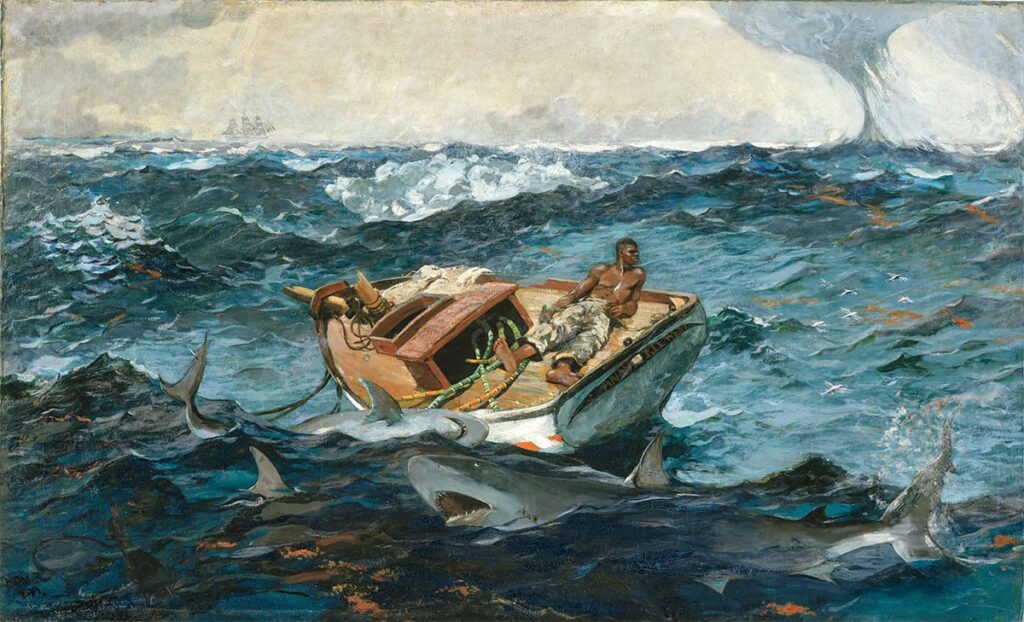Buckle up as we embark on a journey through the maritime masterpiece that is Winslow Homer’s The Gulf Stream. Painted in 1899, this captivating artwork plunges us into the tempestuous seas, where a lone figure battles against the forces of nature. In this blogpost, we’ll navigate the life of Winslow Homer, surf the crests of his artistic career, plunge into the depths of The Gulf Stream, and unveil the fascinating details that make this work a timeless treasure.
Who was Winslow Homer?

Picture a chilly February day in 1836, Boston, where Winslow Homer came into the world. Initially a maestro of doodles for advertisements and magazines, Homer’s artistic trajectory took a seismic shift in his 30s when he fell head over heels for oil painting. From sketching scenes of the Civil War to crafting gallery of images that could rival the ocean’s grandeur, Homer became a luminary in the art of America, weaving emotions and narratives with his brushstrokes.
His Career
Winslow Homer’s painting story is nothing short of a blockbuster film script. Starting as an illustrator during the Civil War, he later transitioned into a realm where he could capture the very essence of the human spirit against the vast backdrop of the sea. By the late 1800s, Homer wasn’t merely a painter; he was a wizard who conjured light, color, and emotions onto his canvas.
What is happening in The Gulf Stream?

| Artist | Winslow Homer |
| Date Painted | 1899 |
| Medium | Oil on canvas |
| Genre | Think maritime realism, with a generous dose of heart and soul |
| Period | Late 19th century |
| Dimensions | 28.2 x 49.6 inches |
| Series/Versions | A singular masterpiece |
| Where is it housed? | The Metropolitan Museum of Art, New York |
Now, envision yourself in the middle of the ocean, storm clouds gathering ominously, and the company of sharks swimming around. This is the turbulent world of The Gulf Stream. At its core, the painting portrays a lone figure on a battered boat, wrestling with the chaos of the sea. Symbolism drips from every stroke, hinting at racial tensions and the societal storms of Homer’s time. It’s a visual rollercoaster, beckoning viewers to reflect on the uncertainties of life.
Interesting Facts
Symbolism at Sea: Those sharks? They’re like underwater poets, symbolizing economic troubles and racial tensions post-Reconstruction.
Debate Galore: The Gulf Stream has sparked endless discussions. Some say it’s a commentary on African American struggles; others see it as a broader take on the nation’s challenges.
Island Vibes: Homer got his mojo for this painting from his time in the Bahamas. The sea there spoke to him, and the people’s resilience left an indelible mark on his art.
The Artistic Odyssey: Back in the day, not everyone was gushing over this masterpiece. But over time, The Gulf Stream became a darling of the art world, cherished for its emotion and social insight.
The Deep Dive
Let’s plunge into the mesmerizing depths of The Gulf Stream. The central figure, a lone African-American man, occupies a fragile vessel amidst turbulent waters. Storm clouds gather ominously overhead, and sharks circle menacingly beneath. In the distance, a waterspout adds an element of impending danger. The scene is a cacophony of chaos, a visual symphony of nature’s wrath and the resilience of the human spirit.
Homer’s use of color is masterful. The palette is dominated by rich, deep blues and grays, intensifying the sense of foreboding. The contrast between the dark, tumultuous sea and the pale, vulnerable figure creates a great visual impact. The foamy waves and the swirling currents are rendered with meticulous detail, adding to the painting’s realism.
Symbolism permeates every inch of the canvas. The lone figure’s stoic expression and the tattered state of his boat suggest a quiet defiance in the face of adversity. The sharks, often interpreted as economic troubles or societal threats, encircle the protagonist, adding an element of danger and vulnerability.
Frequently Asked Questions
What is the interpretation of The Gulf Stream by Winslow Homer?
There is a sense of abandonment in Homer’s tale with its circling sharks, shattered mast, lone figure, rising water spout, and boundless sea. The ship on the far left gives the impression that civilization is both present and entirely unachievable, giving the observer a sense of being both close and far away.
Where is the largest collection of Winslow Homer paintings?
One of the largest collections of Homer’s artwork in any media, encompassing wood engravings, etchings, watercolors, drawings, and paintings from almost every stage of his career, is kept at the Clark Art Institute.
Conclusion
Winslow Homer’s The Gulf Stream is not just a painting; it’s a voyage into the heart of human experience. Through Homer’s expert brushstrokes, we navigate the tumultuous seas of life, where storms may brew, sharks may circle, but the human spirit endures. This maritime masterpiece, housed in The Metropolitan Museum of Art, stands as a testament to Homer’s skill to capture the essence of an era while transcending it, inviting viewers to ride the waves of emotion and contemplation.













